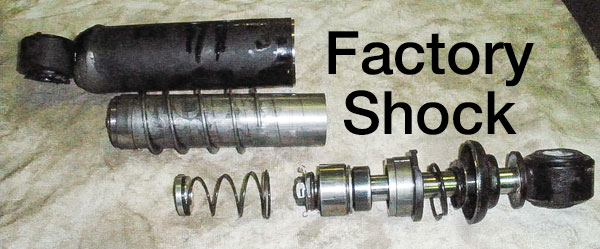
All About the Hummer Shocks
Updated March 18, 2022
The newest Hummer H1 is now 6 years old. I remember when some of my friends got 2000's which in my mind is considered new. Now those trucks are 12 years old. My 98 is 14 years old. Since most of the Hummers have changed hands, most owners don't have a feel how the trucks are supposed to handle. The shocks in most of the trucks have never been replaced. How many of you have a car that's 10 to 14 years old? There a real good chance that the shocks and struts have probably been replaced at least once or twice. This is probably the most overlooked maintenance item on the truck.

What do Shocks do?
 The Hummer has a 4 wheel independent suspension with a coil spring and shock located in the center of the spring at each wheel. The shock absorbers job is to control the springs. When you hit a bump it's the spring that absorbs the lions share of the energy. It will compress and then 'spring back'. In fact without a shock the spring will continue to oscillate back and forth (twang) until the energy in the spring is used up. This, of course causes instability in vehicle handling. Imagine hitting a big off road dip. You want your truck to come back up and stop, not to continue bouncing up and down. Shocks are often called dampers because that's what they actually are. Their main job is to dampen the spring oscillation. Worn shocks can cause premature tire, steering and suspension component wear. They also cause dangerous instability through excessive sway.
The Hummer has a 4 wheel independent suspension with a coil spring and shock located in the center of the spring at each wheel. The shock absorbers job is to control the springs. When you hit a bump it's the spring that absorbs the lions share of the energy. It will compress and then 'spring back'. In fact without a shock the spring will continue to oscillate back and forth (twang) until the energy in the spring is used up. This, of course causes instability in vehicle handling. Imagine hitting a big off road dip. You want your truck to come back up and stop, not to continue bouncing up and down. Shocks are often called dampers because that's what they actually are. Their main job is to dampen the spring oscillation. Worn shocks can cause premature tire, steering and suspension component wear. They also cause dangerous instability through excessive sway.
A spring is made of steel and like any steel it weakens every time it flexes. If your shocks are bad or not properly set up for the kind of driving you do the spring will not be damped and continue to cycle. This causes the steel to fatigue which is why springs prematurely wear out.
How Would I know if I Need Shocks for my Hummer?
 This is hard to notice because the shocks deteriorate over time and the problem slowly worsens. It just doesn't happen all at once unless you out and out break one. Years ago my vacuum pump went bad. As you know the vacuum runs the turbo wastegate. Over time I didn't even notice I wasn't getting boost. Now I have a turbo boost gauge but things went bad so slowly I didn't notice what I was missing till I got it all back at once.
This is hard to notice because the shocks deteriorate over time and the problem slowly worsens. It just doesn't happen all at once unless you out and out break one. Years ago my vacuum pump went bad. As you know the vacuum runs the turbo wastegate. Over time I didn't even notice I wasn't getting boost. Now I have a turbo boost gauge but things went bad so slowly I didn't notice what I was missing till I got it all back at once.
Because our trucks are so heavy and the springs are so heavy duty you usually can't just bounce a corner of the truck and see if the truck continues to bounce up and down like you can with a car. One way to test them is to drive into a dip at about 3 to 5 mph. When you come up and out of the dip the truck will shoot up, come down and compress a bit and should rest level. If your shocks are weak the truck will shoot way up high, come down fast then rise up a second time and depending on how bad the shocks are it could just bounce. The spring is what takes the energy from the hit. The shock is meant to damp the springs (keep the spring from 'twanging').
The other way to know if your shocks are worn is if your truck sways in the corners. This is another one of those 'I don't remember how it's suppose to be' things. In fact I'll bet that most of the owners never experienced how well their truck handled when it was new because they bought their trucks used. If you're going around a corner and the truck feels 'sloppy' and sways some it's a shock thing. All I can say is that if you ever felt like you could lose it getting off on a curved highway exit ramp then these shocks will go a long way to alleviate that fear.

